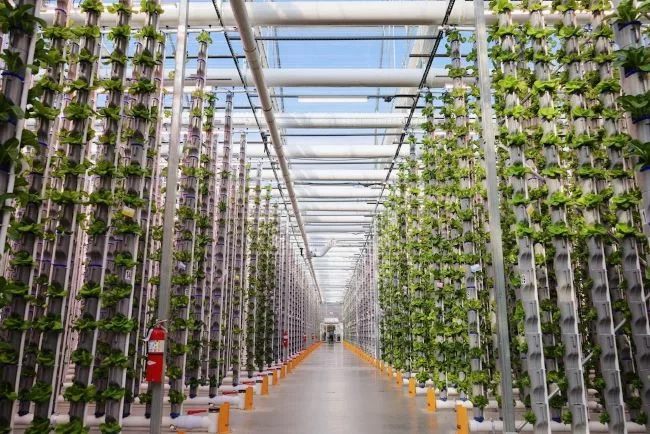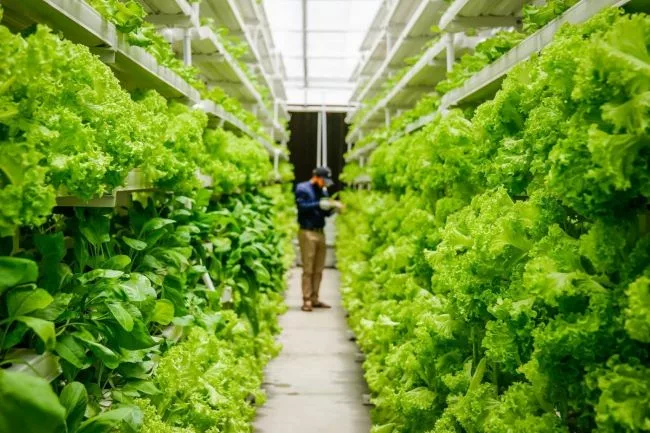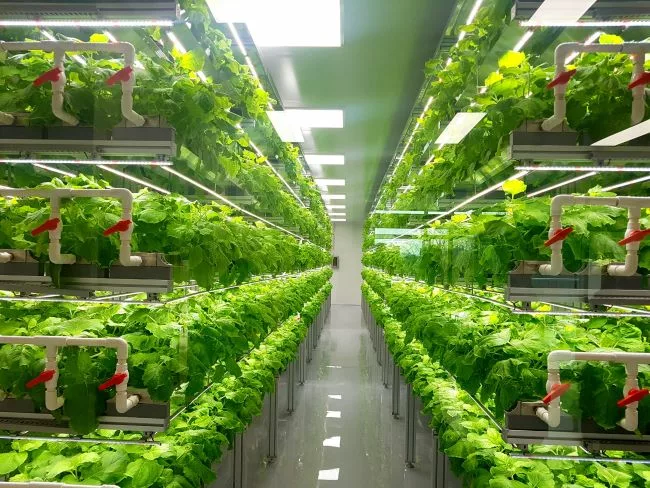In order to alleviate the contradiction between China's existing agricultural land and food demand, and to improve the urban ecological environment, we analyze the successful cases of foreign vertical agriculture by sorting out the development history of foreign vertical agriculture, and distill from them the useful experience for the development of vertical agriculture in China, so as to promote the development of vertical agriculture in China.

According to data from the National Bureau of Statistics, by the end of 2019, China's population totaled 1.4 billion, still the most populous country in the world. And the arable land area at the end of 2019 was 135 million hm2 , which is 5% less compared with last year, and the contradiction between people and land is aggravated. In recent years, the total income of China's residents has continued to increase, and people are paying more attention to food quality, and the demand for green and organic food is growing.The No. 1 document of the central government in 2019, "Opinions on adhering to the priority development of agriculture and rural areas and doing a good job in the work of the three rural areas", pointed out that it is necessary to vigorously develop the production of scarce, green and high-quality agricultural products and promote the transformation of agriculture from production-oriented to production-oriented. It is necessary to vigorously develop the production of scarce, green and high-quality agricultural products, shift agriculture from production-oriented to quality-oriented, and ensure the effective supply of important agricultural products. Vertical agriculture has the advantages of less land, high yield and high quality, etc. In July 2017, Plenty, an indoor agriculture startup in Silicon Valley, is preparing to build more than 300 vertical farms in China's cities after obtaining $200 million in financing. Therefore, exploring vertical farming is a big trend for China.
The concept of vertical farming
The concept of "vertical farming" was first introduced in 1915 by the American geologist Gilbert Ellis Bailey. He envisioned maintaining crops in urban skyscrapers by simulating the temperature, water, and light required by crops. But what really brought vertical farming into the public eye was a 1999 course project researched by Dixon Desparmier, a professor at Columbia University in New York. Prof. DeSpamier proposed that agricultural production could be extended to the interior of a building, and that such a building would be the prototype of a vertical farm. Vertical farming in the modern sense has evolved into a new type of agricultural model to cope with the future population increase and the lack of land and water resources, based on modern planting technology, computer technology and architectural planning technology, planting crops and breeding animals in urban buildings, in order to reduce the pressure on agricultural land, increase crop yields and alleviate the urban heat island effect.
Vertical agriculture development history at home and abroad
Vertical agriculture development so far, after people's practical exploration gradually derived from vertical farms, surface agricultural buildings and indoor three-dimensional cultivation of three forms of application, indoor three-dimensional cultivation development time is shorter.
Vertical agriculture development history in foreign countries
The origin and development of epidermal agriculture. Vertical agriculture in the 20th century and the rapid development of the rise of skin agricultural buildings: the early 20th century, Le Corbusier in its design of the Savoye villa for the first time to realize the roof planting; the 1940s, St. Petersburg, Russia, to carry out the roof planting in order to solve the problem of food shortages; in the 1960s to the 80s, some countries in Europe have begun to study the technology related to roof planting, supported by government policy, and the development of indoor stereo cultivation. Between the 1960s and the 1980s, some European countries began to study technologies related to rooftop planting, and with the support of government policies, the research on rooftop waterproofing materials, water circulation systems, and plant configurations in these countries became more and more mature; at the end of the 20th century and the beginning of the 21st century, most countries in Europe had developed rooftop planting into an industry, and gradually combined agricultural production with rooftop planting. Subsequently, James Pate formally put forward the concept of surface agricultural buildings, that is, general urban buildings as a carrier, the use of balconies, walls, roofs and the open space in front of and behind the house for agricultural production activities.
The origin and development of vertical farms. Vertical farms are another carrier of vertical agriculture. Vertical agriculture has a long history abroad, and according to relevant documents, it originated in the aerial gardens of ancient Babylon and the vertical layered planting of South American natives. The air garden adopts the form of three-dimensional gardening, planting flowers and grasses between the upward stacked platforms, which is the first example of human beings utilizing vertical space for planting flowers and grasses. The concept of the Vertical Farm was first proposed by Professor Dixon Desparmire in 2007, and in 2008, at the 25th Passive and Low Energy Buildings Conference held in Dublin, Tiffany Beres applied architecture to vertical farming and emphasized the agricultural production function of the Vertical Farm. Since then, vertical farms have become the main application form of vertical agriculture in foreign countries because of its systematic and intelligent nature.
Development History of Domestic Vertical Farming
Epidermal agriculture origin and development. The development of vertical agriculture in China started late, but has shown strong momentum. Starting from the 1960s, rooftop garden planting projects have been carried out in Chongqing and Chengdu; in the 1970s, the first large-scale rooftop garden was built in the Oriental Hotel in Guangzhou, which was the prototype of China's epi-agriculture construction. Nowadays, residents spontaneously grow vegetables on the balconies of their homes, which laterally pushes forward the development of the skin agriculture building.
Origin and development of vertical farms. Vertical farms originated in the 1990s, when scholars represented by Qian Xuesen put forward the concept of "landscape city", which was divided into three realms of large, medium and small, and the small realm was for urban buildings, which should realize people's multifunctional needs. In 2010, China's first vertical farm design program "Green Beauty" skyscraper tower came out in Shenzhen, "Green Beauty" set of vertical farms, garden hotels and green eco-tourism as a whole; in 2011, according to Xinhua, the first full-intelligent control of the whole intelligent control in Shandong. In 2011, according to Xinhua News, Shandong's first three-dimensional vertical agricultural demonstration park with full intelligent control began construction, and the demonstration park realized full monitoring of the crop growth environment; in 2015, at the Global Youth Summit on the theme of "how to cope with the problem of global hunger", Zhejiang Agricultural and Forestry University student Shan Youxia put forward the idea of using the city's rotten buildings to build vertical farms, both rational use of existing resources, and the construction of vertical farms. This not only rationally utilizes existing resources, but also saves construction costs.

Typical Case Studies of Vertical Farming in Overseas Countries
As the global urban population continues to expand, agricultural land is decreasing, and at the same time, natural forces, such as extreme weather, are having a greater and greater impact on crops. Therefore, experts and scientists in the field of agriculture have begun to favor the development of vertical agriculture, and have explored how to apply vertical agriculture, and then designed some excellent application programs.
Typical Cases of Vertical Agriculture in Overseas Countries
Aero Farms in the United States.
In 2016, Aero Farms broke ground in Newark, New Jersey, the United States. The vertical farm occupies an area of about 6400m2 and can produce 22 kinds of crops and 910,000 kg of vegetables annually, making it the largest vertical farm in the world. Utilizing the latest technologies such as LED lighting, aeroponics, and environmental controls, the farm's scientific farming system allows plants to grow and develop without the need for soil, sunlight, or pesticides. Aero Farms is located just 15 miles from New York, and has already established relationships with a number of supermarket chains, including Whole Foods, an organic supermarket near New York.
Crop One Farms, Dubai.
In June 2018, Emirates Airline Catering Corporation (EKFC) and U.S.-based vertical farm startup Crop One signed a $40 million co-investment agreement that will see the two companies establish a global vertical farm in November 2018 in Dubai. The vertical farm is expected to cover an area of 12,000m2 and produce up to 2,700kg of green, organic and pollution-free vegetables per day, and will require 1% of the water required for outdoor farming. The farm is located just 30 miles from downtown Boston, and Crop One says the vegetables can be harvested and delivered to consumers in 24 hours. The farm is also expected to replace Aero Farms in New Jersey, USA, as the world's largest vertical farm.
Sky Greens Singapore.
Singapore has created a 6m high A-shaped tower that utilizes the "A-Go-Gro" vertical farming system. The 6m2 tower consists of 26 floors of planting tanks, with different types of vegetables planted in trays on each floor. Each floor rotates at a speed of 1mm per second, and the stepped arrangement ensures that all plants receive sufficient light. A water gravity system automatically collects rainwater, which is then filtered into the irrigation system after powering the rotating system. When comparing energy consumption, the "A-Go-Gro" vertical planting system uses as little energy as a 60-watt light bulb, making it a low-carbon solution. In addition, visitors can also participate in crop picking and experience the fun of harvesting.
Scunthorpe Vertical Farm, UK.
In November 2018, the UK's first vertical farm was opened on an industrial estate in Scunthorpe, UK. This vertical farm was built by a food company, with a total planting area of about 220m2 , and is expected to produce 500t of plants per year, including vegetables such as chives, parsley and basil, to meet the needs of urban residents. At the same time, the farm adopts the hydroponic farming mode, and all the nutrients required by the plants are provided by the water solution. In addition, the farm regularly discharges the water solution to provide sufficient oxygen for the plants, and the whole process is automated.
Features of Vertical Farming Application Design in Foreign Countries
Vertical farms are close to consumer markets and mainly grow green organic vegetables.
Aero Farms in the United States and Crop One in Dubai are both close to consumer markets, and the time from harvesting to transportation to consumers is very short, which shortens the transportation mileage of vegetables, ensures the freshness of vegetables, and at the same time, reduces the use of fossil fuels, thus purifying the urban atmosphere. In addition, the high cost of building vertical farms has led to the selective growing of certain crops. According to the current projects of vertical farms in foreign countries, the crops planted are mainly green organic vegetables with high profits.
Actively develop "intelligent" vertical farming.
Most of the vertical farms in foreign countries are located in high-rise buildings, where high-rise crops can obtain natural light through the roofs of the buildings, while low-rise crops cannot fully receive light, and therefore need to rely on both natural light and artificial light. Most of the artificial lighting systems in the buildings use LED lighting, which realizes the adjustability of light and light quality and provides the required light environment for different kinds of crops. The Vertical Farm is fully automated with computerized management technology to control the temperature, light and carbon dioxide levels, as well as the nutrient levels. During the operation of the farm, the whole process of crop production and development is monitored in real time, and environmental factors are adjusted to maximize the potential of crop production. In addition, the vertical farm utilizes artificial intelligence to replace manual management and automate its daily operations.
Efficient utilization of resources while ensuring green operations.
Vertical farms do not use herbicides, pesticides, fertilizers, etc. in the planting process, avoiding pests and diseases, and producing greener and more environmentally friendly agricultural products. Vertical farms, as green factors in the city, some of them have the function of treating waste water from organic wastes in the city. By recycling and purifying wastewater, vertical farms help to eliminate agricultural wastewater that is potentially harmful to the environment and human health. Much of the purified wastewater is used for irrigation, and some can be converted to drinking water, improving water efficiency. In addition, the designers used architectural techniques to maximize the farm's use of solar radiation and to make full use of light resources in order to reduce energy consumption.

Implications for the development of vertical agriculture in China
The rise of vertical agriculture has provided a new way of thinking for solving the future food production crisis in China, and the successful experience of foreign countries in applying vertical agriculture has also brought new inspirations and opportunities for the development of vertical agriculture in China. So far, although there are still many problems in the practice of vertical agriculture in China, we should try to make use of the advantages of vertical agriculture, and give certain support to the development of vertical agriculture in China, so that vertical agriculture can play a maximum role in China's agricultural production and ecological protection.
Play the role of government guidance, make up for the short board of technology and talent
Compared with developed countries, China's agricultural mechanization and automation level is low, material technology and equipment are backward, and there is a lack of research on vertical agriculture related technology in China, so if we invest in vertical farms blindly, we will fall into the predicament of high input and low return. Therefore, the government should take the responsibility of developing vertical agriculture, increase the capital investment in vertical agriculture, and vigorously support the research and development of related technologies. At the same time, the government should also formulate incentive policies to encourage enterprises to invest in vertical agriculture. In addition, as a brand-new mode of agricultural production, the design and application of vertical agriculture is a specialized and systematic project involving multidisciplinary knowledge in architecture, material science, biology and computer networks. Therefore, China needs to
Therefore, China needs to introduce and cultivate complex technical talents, change the situation of relying on foreign technical talents, enhance the ability of independent innovation, and combine modern agricultural technology with other technologies to support the development of vertical agriculture in China's cities.
Promote small-scale vertical farms to raise people's awareness
China is a large agricultural country, and the traditional farming culture has lasted for thousands of years. Vertical farming, as a new concept, may be difficult to be accepted by the public for a while. Therefore, the government should popularize the knowledge related to vertical farming, so as to clear people's doubts about the "unnatural products" produced by vertical farming, and let people really understand the green and healthy food produced by vertical farming. In addition, given China's current level of economic development and technology, it is difficult to build a large-scale vertical farm in a short period of time. Therefore, it is possible to launch some small and simple vertical farms first to increase people's awareness and gain social acceptance. These farms can be used as experimental bases to collect data on the growth of plants and animals and cultivate new types of crops; they can also be used as research platforms to research and develop modern science and technology related to vertical agriculture and cultivate comprehensive technical talents.
Incorporating Green Concepts into Vertical Farming
Energy consumption is a major obstacle to the development of vertical farms. The use of LED lighting system consumes a lot of electricity and cannot meet the demand for energy saving and environmental protection. Therefore, we should make full use of the solar energy in the western region and the southern region of China to convert solar energy into electricity for the internal energy supply of vertical farms. At the same time, the development and utilization of wind energy and water resources in the eastern coastal area can contribute to energy saving and emission reduction while saving costs and improving economic efficiency. In addition, as an oasis in the city, vertical farms can shorten the transportation mileage of crops, which not only reduces the transportation cost, but also reduces energy consumption and carbon dioxide emissions. Therefore, it is possible to increase the number of green plant cultivation areas in urban buildings, whose transpiration can remove a large amount of indoor heat and keep the indoor area cool, thus lowering the surrounding temperature and mitigating the urban heat island effect.
Explore the application of vertical farming in line with China's current development situation.
Different countries have different economic levels and social development, so China should try to develop the following forms of vertical agriculture by combining with the humanistic and geographic environment of its own cities: first, to create indoor farms with the theme of leisure agriculture and parent-child education. The main function of this kind of farm is to popularize science and spread the concept of green and healthy life, and the "Pea Farm", an indoor theme farm in Shijiazhuang, Hebei Province, in 2015, is a good example. Secondly, the construction of complex functional buildings integrating production, leisure and offices. Creating functional buildings will attract investment from various fields and effectively reduce the operational risks of vertical farms. Thirdly, vertical farming can be developed by utilizing abandoned urban buildings. Finally, use existing buildings such as houses and office buildings to develop surface agriculture and indoor three-dimensional cultivation, so that people can grow vegetables after work, which not only enriches the food baskets of urban residents, but also provides a place for urban residents to relax and have fun.
